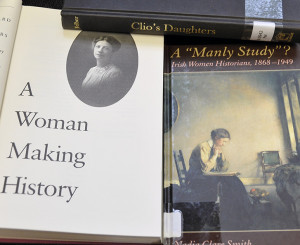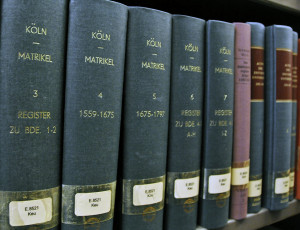Kate Wilcox is Reader Experience and Technical Services Manager at the Institute of Historical Research Library.
 The IHR library staff have each been researching a topic, in an experiment designed to improve our understanding of what it’s like to use the collections. I’ve been looking at our holdings for the historiography of women historians, something I didn’t know much about and thought would be interesting. As a starting point I searched the catalogue, using ‘Women historians’ as a keyword and a subject.
The IHR library staff have each been researching a topic, in an experiment designed to improve our understanding of what it’s like to use the collections. I’ve been looking at our holdings for the historiography of women historians, something I didn’t know much about and thought would be interesting. As a starting point I searched the catalogue, using ‘Women historians’ as a keyword and a subject.
The library’s collection policy for works on historiography extends beyond its usual remit of primary sources, so I found secondary works as well as sources. They are shelved either within the relevant geographical collections, or, for more general works, within the historiography section at classmark E.1441. Examples include:
- The gender of history : men, women, and historical practice (General collection)
- Histoires d’historiennes (French collection)
- Nuns as historians in early modern Germany (German collection)
- Novel histories : British women writing history, 1760-1830 (British collection)
- Clio’s daughters : British women making history, 1790-1899 (British collection)
- A “manly study”? : Irish women historians, 1868-1949 (Irish collection)
- Clio’s southern sisters : interviews with leaders of the Southern Association for Women Historians (United States collection)
- Telling histories : Black women historians in the ivory tower (United States collection)
- ‘ “Ample proof of this may be found” : early black women historians’ in African American history reconsidered (United States collection)
- A field of their own : women and American Indian history, 1830-1941 (United States collection)
The last one is a new book, which when I checked the catalogue was still marked as ‘processing’. Books in processing can usually be retrieved for readers by library staff.
The collection includes works on individual women historians, in monographs, journal articles and series. For example:
- Eleanora Mary Carus-Wilson, 1897-1977
- A Victorian marriage : Mandell and Louise Creighton
- A woman in history : Eileen Power, 1889-1940
- Pauli Murray & Caroline Ware : forty years of letters in black and white
- A woman making history : Mary Ritter Beard through her letters
The whole library is reference only, so you will usually find open-access items available on the shelves. I found a couple of secondary works that I wanted to read fully, and because Senate House Library also held them, I was able to borrow them to read on the train home. This was also an opportunity to use a library that I’m less familiar with and think about the experience of shelf labelling and signage.
Bibliographies
The IHR library has a lot of specialist bibliographies, but I only located one focussing on women historians, Scritti storici di donne italiane : bibliografia, 1800-1945. The comprehensive online Bibliography of British and Irish History is always a useful resource, though I found it hard to find closely defined search terms for my subject and it was more productive to browse through the results from a wider search. As well as material directly on women historians, BBIH helped me locate material on the wider context, such as women in education.
Biographical works
I also tried a biographical approach. The catalogue search had retrieved a specialist work, American women historians, 1700s-1990s : a biographical dictionary. For the UK, the online Oxford Dictionary of National Biography allows searching by the ‘field of interest’ of its subjects, so by using the drop-down menus I was able to search for ‘Scholarship and research: history: historians (general)’ and filter by gender, finding 103 female historians (compared to 922 male historians). The list of names is an obvious starting point for researching individual careers.
As another way into the topic, I was interested to see how many of their published works are held among the IHR’s collections. As examples, we have works of some of the earliest women historians, including Lucy Aikin (1781–1864), who edited Memoirs of the courts of Elizabeth I and James I, the prolific editor Mary Anne Everett Green (1818–1895) and the pioneering castle archaeologist Ella Armitage (1841–1931).
University records and Histories
Another biographical approach is to think about the educational background of women historians. The library has outstanding collections on the history of British, European and American universities, with many biographical registers. The relevant areas are:
- Biographical works, British universities, colleges, schools (B.27)
- Histories of individual universities, within the regional collections, for example Oxford under Oxfordshire (BC.76), Scottish universities in Scottish Local collection (BSL), European universities (E.8) and United States universities (currently UF.52, undergoing reclassification).
 While invaluable for researching individual careers, the registers are not particularly usable for a systematic review, usually being organised by name, from which gender often has to be deduced. It would be useful to have the data in a more structured format. However many include useful information about parents’ occupations, whether the mother had attended university, and the student’s subsequent career.
While invaluable for researching individual careers, the registers are not particularly usable for a systematic review, usually being organised by name, from which gender often has to be deduced. It would be useful to have the data in a more structured format. However many include useful information about parents’ occupations, whether the mother had attended university, and the student’s subsequent career.
Looking for female reviewers and authors in long-running journals and the IHR’s Teachers of history and Theses lists could be an interesting approach. Early volumes of these series often follow a standard approach of using initials for men and forenames for women.
I found that for using the registers and other sources that some background information was essential, such as knowing when history became a separate discipline in different universities, and when women were admitted to study it. The IHR library has useful holdings for researching the background including parliamentary material, collections of letters and diaries and newspapers.
Using the library
I found the library rooms generally a pleasant place to work. There are some noise issues that we are already aware of and trying to address. Although we want to be welcoming, we try to keep the enquiry office door closed so that we don’t disturb readers in the main room, and we ask that when rooms are used for meetings the doors are kept closed. We’ve also been trying to get the landing doors adjusted to stop them slamming.
Like many of our readers, I found it difficult to browse series shelved in the rolling stacks. The reason why the library now has rolling stacks in the largest rooms is to allow more of the collection to stay on open access in what has become a reduced space. When we were planning the new library rooms, it was not possible to use the rolling stacks for the less browse-worthy parts of the collection without disrupting the sequence of shelfmarks and making items difficult to locate. For similar reasons of space, the European university histories/registers are held in closed access, but we are always happy to meet the needs of readers who want to browse runs of closed-access material by bringing them to the library. We are continuing to think about ways of making the rolling stacks less of an issue.
Beyond the library collections, the IHR archive is a valuable source of material about women historians. Membership records, seminar registers and correspondence contain useful information for understanding the place of women in the history profession. We are currently fundraising to catalogue the archive and improve access to it. The IHR also hosts seminars in several related fields, including Women’s history, History of Education, and Gender and History in the Americas. There are occasionally other events such as the forthcoming lecture and book launch “Keep the Damned Women out”: The Struggle for Coeducation (31 Oct 2016). All in all, I found the IHR a good place to start research on the topic I’d chosen, and what I discovered here made me interested in finding out more.
